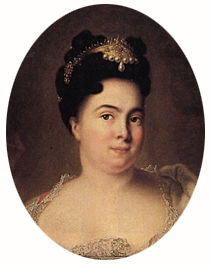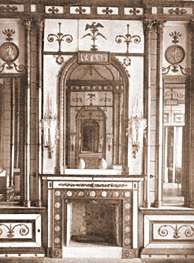 Left: Catherine I.
Left: Catherine I.
The Great Catherine palace was named for Catherine I, the wife of Peter the Great. Catherine came from the lower classes, she had been a camp follower and mistress to one of Peter's top advisors before the Tsar took her for himself. He had four children with her, two boys (who died in childhood) and two daughters who ruled Russia in turn.
Catherine built a small stone house in Tsarskoe Selo and her husband adored the house and it's wooded surroundings. Later, when their second daughter, Elizabeth I, was on the throne she had the palace greatly enlarged by Rastrelli. He built her another baroque wonder; blue and white with miles of gaudy gilt on the facade. The immense length of the palace made it the longest in Europe, although the French snootily trashed the architecture as bizarre and vulgar.
Elizabeth had many gala parties at the palace and its' spacious rooms gave her space for the thousands of dresses, hats and shoes she had made for herself every year. Her clothes were made of the finest materials - expensive silks and satins were imported from China and Western Europe. Elizabeth was a big woman who's weight fluctuated widely. Many of the dresses she ordered were too small when delivered and impossible to get on her. Her maids were often in despair and subjected to her rages when they couldn't dress her in what she wished to wear. Often Elizabeth needed to be literally sewn into her dresses and then cut out of them afterwards by her maids. This meant many dresses could only be worn once - if at all.
Elizabeth had a notion that she was very attractive in men's clothes. Someone had once remarked how handsome her legs looked in men's breeches and stockings, so she organized balls and events in which the men were required to dress as women and the women as men. This may have been flattering to Elizabeth, but it made most everybody else look and feel ridiculous. No one could refuse her wishes however, and all had to obey.
On December 23, 1761 Elizabeth was attending mass at the nearby Church of the Sign, a few steps from her palace. She felt unwell during the service and suddenly suffering a massive convulsion, was struck speechless and fainted. She was carried out onto the snow in front of the church while her dazed courtiers wondered what to do. Someone had the presence of mind to order a sofa to get the Empress off of the snow. A gilt wood and silk sofa was brought down to the church and Elizabeth was moved onto it. She was carried back to the Catherine Palace on it. Unfortunately nothing could be done and the Empress died on Christmas Day.
She was succeeded by her worthless nephew, Peter III, who was soon overthrown by his wife, who was become Catherine the Great. Peter was forced to abdicate his throne and was quickly murdered by supporters of his wife. The official explanation was that Peter had died of hemmorhoids (the source the famous satirical comment "...only in Russia is hemmorhoids a fatal condition!").
 Right: Charles Cameron in "Russian" garb.
Right: Charles Cameron in "Russian" garb.
Catherine loved Tsarskoe Selo both in leafy summer and the bleak winter. She made extensive modifications to the palace, creating a huge group of rooms in the neo-classical style which was then in vogue all across Europe. To design and decorate her rooms she enlisted a Scotsman, Charles Cameron. An exotic adventurer of uncertain origins, Cameron had completely absorbed the classic Adam style in Great Britain - bringing it to Russia in a much more intense, even sensual, interpretation. When she wasn't fighting wars, Catherine had virtually unlimited funds to spend on building, which was a passion for her. She also had access to rare materials including semi-precious stones from the Urals. What she couldn't find locally she imported. This included luxury decorating products - like classical Wedgewood plaques - and foreign craftsmen in bronze working, glass making and plaster carving, skills she felt were lacking in Russia. With the finest materials and craftsmen of Europe at his disposal - and with the total support of the Empress, Cameron in the 1780s produced some of the most beautiful interiors of the time. In the Catherine Palace Cameron created a private suite of rooms for the Empress called the "Fifth Apartment". Here Cameron and Catherine went completely in the Pompeiian style with delicate violet glass columns crowned with bronze capitals, walls panelled in felt covered with more glass - this time milky white - exquisite gilt and other decoration inspired by ancient Rome and Hellenistic Greece.
 Left: The fireplace in Catherine's bedroom.
Left: The fireplace in Catherine's bedroom.
While Catherine was blessed with power, a fortune, and good taste she was cursed by a terrible relationship with her only son, Paul, who despised her and everything associated with her. Paul had been mistreated as a child. Immediately after his birth Empress Elizabeth stole the infant from Catherine (leaving her alone and unattended) and raised him as her own, restrained in swaddling clothes sweating and suffering in overheated, stuffy rooms and fussed over by court ladies. His mother was kept away and Paul grew up resenting his mother and her seeming indifference to him. When Elizabeth died - followed quickly by the abdication and death of Peter III many people expected Paul to succeed his father on the throne. Believing herself the best person for the job of ruling the Empire and the danger to Russia - and herself - of a juvenile on the throne controlled by others, Catherine assumed the crown herself as sole ruler. Years of misunderstandings and perceived slights followed between son and mother. Paul showed definite signs of instability and even mental illness.
As Catherine got older she became acutely aware of her own mortality. She became fatter and watched the decline of her body; she was frequently ill and found it harder and harder to put in the long hours of work she had been used to. Catherine thought more and more about all that she had accomplished and her legacy. Paul had a big mouth and went around telling everyone that he intended to undo everything his mother had done. Pavlovsk and Gatchina, Paul's estates near Petersburg were organized along military lines for Paul considered himself to be a brilliant soldier and a 'mans-man'. Short, ugly and a shrill disciplinarian, most everyone - except Catherine - was afraid of Paul, even his own wife and children.
 Left: Paul I.
Left: Paul I.
Catherine decided to make her blond and handsome grandson, Alexander her heir - passing over her son. She wrote a secret document outlining this and hid it away in her personal papers. Unfortunately the degree became known and this, of course, made Paul hate his mother even more. In the early 1790's when Catherine made her decision Alexander was still very young. She attempted to speed up his maturity and married him off at the age of 16 to a German princess and built him the grand neoclassical Alexander Palace next to hers in Tsarskoe Selo as his wedding gift.
Every morning Catherine rose early, drank incredibly strong coffee that would usually have given anyone else the shakes, and set right to her responsibilities as Empress. One day in November 1796, she had finished her coffee and retired to her toilet. When she didn't come out for a long time her maid and servants became alarmed and forced the door open. There on the floor was Catherine, who had suffered a massive stroke. They hauled her to bed and called Paul to her room. It was obvious death was near. Giddy with joy at the prospect of gaining power Paul rushed to his mother's side to watch her die and make sure her personal papers were seized. Lucky for Paul, his son Alexander, who knew of his grandmother's secret decree naming him her heir, swore loyalty to his father as Tsar. On November 16, 1796, two days after her stroke, never regaining consciousness, Catherine died in the Hermitage. Paul found her decree on the succession and immediately destroyed it
As Catherine's favorite residence, Tsarskoe Selo suffered Paul's wrath. The new Tsar closed the Catherine Palace, emptied its rooms and sealed it shut. Literally abandoned, the palace remained in Imperial disfavor throughout the reign of Paul. The buildings decayed and the gardens - once so meticulously maintained during Catherine's reign - were allowed to become weedy, overgrown and derelict.
Next photograph: An Imperial Gym
For a small map of the St. Petersburg area click here.
To see a large map of the center
of St. Petersburg go here.
Comments on the website should be sent to Bob
Atchison.

